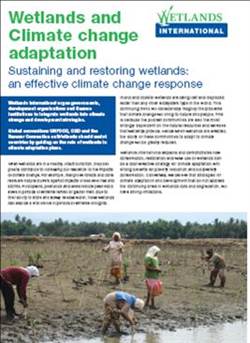
Wetlands and Climate Change Adaptation Brochure
-
Aquaculture, fisheries and coastal agriculture
-
Climate and disaster risks
-
Coastal resilience
-
Coastal wetland conservation
-
Community resilience
When wetlands are in a healthy, intact condition, they can greatly contribute to increasing our resilience to the impacts of climate change. Wetlands International presents in this brochure three cases on how wetlands can play a significant role in adaptation to climate change.
The conservation and restoration of ecosystems, in particular wetlands, could be one of the most cost-effective strategies to adapt to the impacts of climate change. Wetlands can reduce the negative effects of sea level rise, extreme weather like heavy rainfall, increased temperatures, severe storms and related phenomena such as melting glaciers, prolonged droughts and increased floods.
3 examples of how wetlands can play a significant role in adaptation to climate change
Wetlands International explains and demonstrates in this brochure how conservation, restoration and wise use of wetlands can be a cost-effective strategy for climate adaptation with strong benefits for poverty reduction and biodiversity conservation. Conversely, we believe that strategies for climate adaptation and development that do not address the continuing crisis in wetlands loss and degradation, will have strong limitations.
Call for action
With this publication Wetlands International urges governments, development organisations and finance institutions to integrate wetlands into climate change and development strategies.
Global conventions UNFCCC, CBD and the Ramsar Convention on Wetlands should assist countries by guiding on the role of wetlands in climate adaptation plans.

